Min Liu
JoyAgent-JDGenie: Technical Report on the GAIA
Oct 01, 2025Abstract:Large Language Models are increasingly deployed as autonomous agents for complex real-world tasks, yet existing systems often focus on isolated improvements without a unifying design for robustness and adaptability. We propose a generalist agent architecture that integrates three core components: a collective multi-agent framework combining planning and execution agents with critic model voting, a hierarchical memory system spanning working, semantic, and procedural layers, and a refined tool suite for search, code execution, and multimodal parsing. Evaluated on a comprehensive benchmark, our framework consistently outperforms open-source baselines and approaches the performance of proprietary systems. These results demonstrate the importance of system-level integration and highlight a path toward scalable, resilient, and adaptive AI assistants capable of operating across diverse domains and tasks.
Ideal Registration? Segmentation is All You Need
Sep 19, 2025Abstract:Deep learning has revolutionized image registration by its ability to handle diverse tasks while achieving significant speed advantages over conventional approaches. Current approaches, however, often employ globally uniform smoothness constraints that fail to accommodate the complex, regionally varying deformations characteristic of anatomical motion. To address this limitation, we propose SegReg, a Segmentation-driven Registration framework that implements anatomically adaptive regularization by exploiting region-specific deformation patterns. Our SegReg first decomposes input moving and fixed images into anatomically coherent subregions through segmentation. These localized domains are then processed by the same registration backbone to compute optimized partial deformation fields, which are subsequently integrated into a global deformation field. SegReg achieves near-perfect structural alignment (98.23% Dice on critical anatomies) using ground-truth segmentation, and outperforms existing methods by 2-12% across three clinical registration scenarios (cardiac, abdominal, and lung images) even with automatic segmentation. Our SegReg demonstrates a near-linear dependence of registration accuracy on segmentation quality, transforming the registration challenge into a segmentation problem. The source code will be released upon manuscript acceptance.
Dual Enhancement on 3D Vision-Language Perception for Monocular 3D Visual Grounding
Aug 26, 2025Abstract:Monocular 3D visual grounding is a novel task that aims to locate 3D objects in RGB images using text descriptions with explicit geometry information. Despite the inclusion of geometry details in the text, we observe that the text embeddings are sensitive to the magnitude of numerical values but largely ignore the associated measurement units. For example, simply equidistant mapping the length with unit "meter" to "decimeters" or "centimeters" leads to severe performance degradation, even though the physical length remains equivalent. This observation signifies the weak 3D comprehension of pre-trained language model, which generates misguiding text features to hinder 3D perception. Therefore, we propose to enhance the 3D perception of model on text embeddings and geometry features with two simple and effective methods. Firstly, we introduce a pre-processing method named 3D-text Enhancement (3DTE), which enhances the comprehension of mapping relationships between different units by augmenting the diversity of distance descriptors in text queries. Next, we propose a Text-Guided Geometry Enhancement (TGE) module to further enhance the 3D-text information by projecting the basic text features into geometrically consistent space. These 3D-enhanced text features are then leveraged to precisely guide the attention of geometry features. We evaluate the proposed method through extensive comparisons and ablation studies on the Mono3DRefer dataset. Experimental results demonstrate substantial improvements over previous methods, achieving new state-of-the-art results with a notable accuracy gain of 11.94\% in the "Far" scenario. Our code will be made publicly available.
Gaussian Primitive Optimized Deformable Retinal Image Registration
Aug 23, 2025Abstract:Deformable retinal image registration is notoriously difficult due to large homogeneous regions and sparse but critical vascular features, which cause limited gradient signals in standard learning-based frameworks. In this paper, we introduce Gaussian Primitive Optimization (GPO), a novel iterative framework that performs structured message passing to overcome these challenges. After an initial coarse alignment, we extract keypoints at salient anatomical structures (e.g., major vessels) to serve as a minimal set of descriptor-based control nodes (DCN). Each node is modelled as a Gaussian primitive with trainable position, displacement, and radius, thus adapting its spatial influence to local deformation scales. A K-Nearest Neighbors (KNN) Gaussian interpolation then blends and propagates displacement signals from these information-rich nodes to construct a globally coherent displacement field; focusing interpolation on the top (K) neighbors reduces computational overhead while preserving local detail. By strategically anchoring nodes in high-gradient regions, GPO ensures robust gradient flow, mitigating vanishing gradient signal in textureless areas. The framework is optimized end-to-end via a multi-term loss that enforces both keypoint consistency and intensity alignment. Experiments on the FIRE dataset show that GPO reduces the target registration error from 6.2\,px to ~2.4\,px and increases the AUC at 25\,px from 0.770 to 0.938, substantially outperforming existing methods. The source code can be accessed via https://github.com/xintian-99/GPOreg.
Beyond the LUMIR challenge: The pathway to foundational registration models
May 30, 2025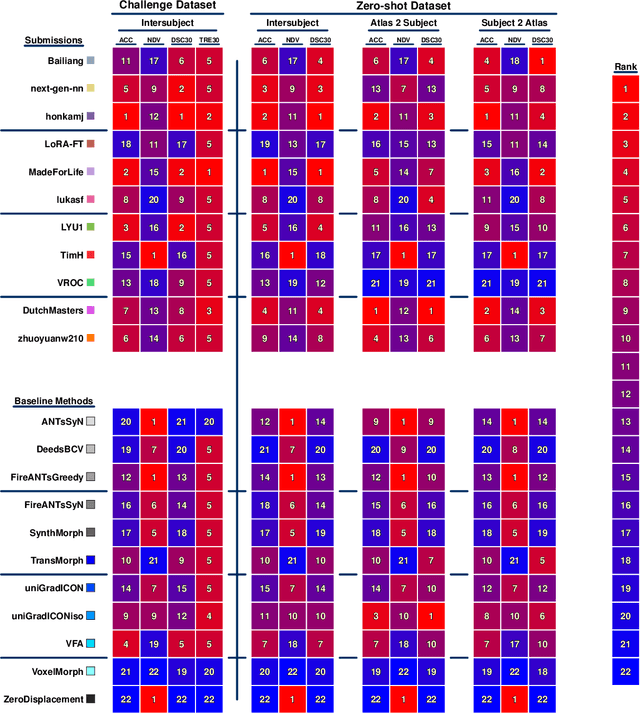
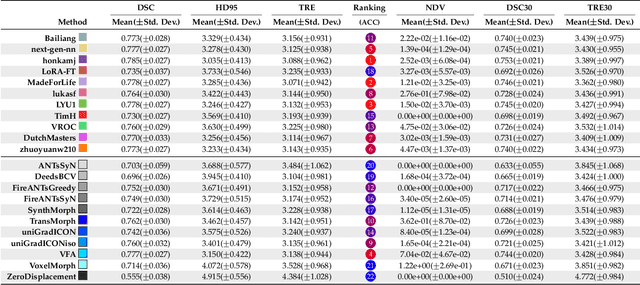
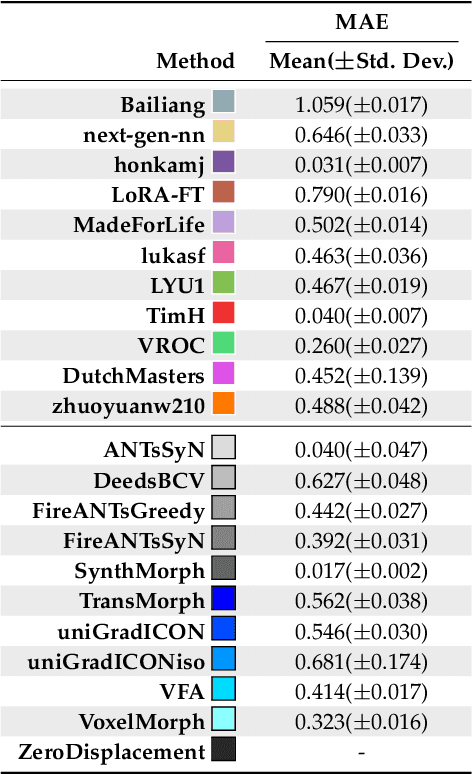
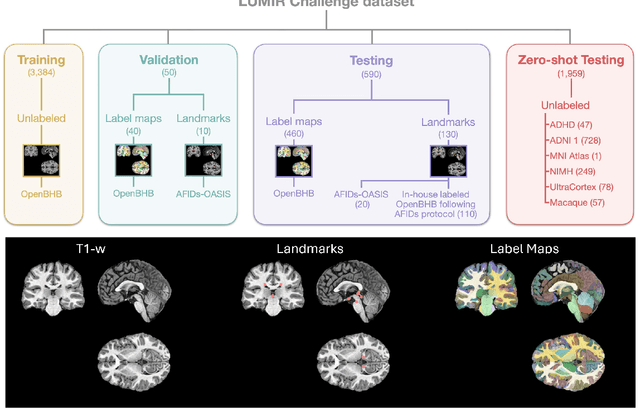
Abstract:Medical image challenges have played a transformative role in advancing the field, catalyzing algorithmic innovation and establishing new performance standards across diverse clinical applications. Image registration, a foundational task in neuroimaging pipelines, has similarly benefited from the Learn2Reg initiative. Building on this foundation, we introduce the Large-scale Unsupervised Brain MRI Image Registration (LUMIR) challenge, a next-generation benchmark designed to assess and advance unsupervised brain MRI registration. Distinct from prior challenges that leveraged anatomical label maps for supervision, LUMIR removes this dependency by providing over 4,000 preprocessed T1-weighted brain MRIs for training without any label maps, encouraging biologically plausible deformation modeling through self-supervision. In addition to evaluating performance on 590 held-out test subjects, LUMIR introduces a rigorous suite of zero-shot generalization tasks, spanning out-of-domain imaging modalities (e.g., FLAIR, T2-weighted, T2*-weighted), disease populations (e.g., Alzheimer's disease), acquisition protocols (e.g., 9.4T MRI), and species (e.g., macaque brains). A total of 1,158 subjects and over 4,000 image pairs were included for evaluation. Performance was assessed using both segmentation-based metrics (Dice coefficient, 95th percentile Hausdorff distance) and landmark-based registration accuracy (target registration error). Across both in-domain and zero-shot tasks, deep learning-based methods consistently achieved state-of-the-art accuracy while producing anatomically plausible deformation fields. The top-performing deep learning-based models demonstrated diffeomorphic properties and inverse consistency, outperforming several leading optimization-based methods, and showing strong robustness to most domain shifts, the exception being a drop in performance on out-of-domain contrasts.
PoisonSwarm: Universal Harmful Information Synthesis via Model Crowdsourcing
May 27, 2025Abstract:To construct responsible and secure AI applications, harmful information data is widely utilized for adversarial testing and the development of safeguards. Existing studies mainly leverage Large Language Models (LLMs) to synthesize data to obtain high-quality task datasets at scale, thereby avoiding costly human annotation. However, limited by the safety alignment mechanisms of LLMs, the synthesis of harmful data still faces challenges in generation reliability and content diversity. In this study, we propose a novel harmful information synthesis framework, PoisonSwarm, which applies the model crowdsourcing strategy to generate diverse harmful data while maintaining a high success rate. Specifically, we generate abundant benign data as the based templates in a counterfactual manner. Subsequently, we decompose each based template into multiple semantic units and perform unit-by-unit toxification and final refinement through dynamic model switching, thus ensuring the success of synthesis. Experimental results demonstrate that PoisonSwarm achieves state-of-the-art performance in synthesizing different categories of harmful data with high scalability and diversity.
OSCAR: One-Step Diffusion Codec Across Multiple Bit-rates
May 22, 2025Abstract:Pretrained latent diffusion models have shown strong potential for lossy image compression, owing to their powerful generative priors. Most existing diffusion-based methods reconstruct images by iteratively denoising from random noise, guided by compressed latent representations. While these approaches have achieved high reconstruction quality, their multi-step sampling process incurs substantial computational overhead. Moreover, they typically require training separate models for different compression bit-rates, leading to significant training and storage costs. To address these challenges, we propose a one-step diffusion codec across multiple bit-rates. termed OSCAR. Specifically, our method views compressed latents as noisy variants of the original latents, where the level of distortion depends on the bit-rate. This perspective allows them to be modeled as intermediate states along a diffusion trajectory. By establishing a mapping from the compression bit-rate to a pseudo diffusion timestep, we condition a single generative model to support reconstructions at multiple bit-rates. Meanwhile, we argue that the compressed latents retain rich structural information, thereby making one-step denoising feasible. Thus, OSCAR replaces iterative sampling with a single denoising pass, significantly improving inference efficiency. Extensive experiments demonstrate that OSCAR achieves superior performance in both quantitative and visual quality metrics. The code and models will be released at https://github.com/jp-guo/OSCAR.
Reconsider the Template Mesh in Deep Learning-based Mesh Reconstruction
May 21, 2025



Abstract:Mesh reconstruction is a cornerstone process across various applications, including in-silico trials, digital twins, surgical planning, and navigation. Recent advancements in deep learning have notably enhanced mesh reconstruction speeds. Yet, traditional methods predominantly rely on deforming a standardised template mesh for individual subjects, which overlooks the unique anatomical variations between them, and may compromise the fidelity of the reconstructions. In this paper, we propose an adaptive-template-based mesh reconstruction network (ATMRN), which generates adaptive templates from the given images for the subsequent deformation, moving beyond the constraints of a singular, fixed template. Our approach, validated on cortical magnetic resonance (MR) images from the OASIS dataset, sets a new benchmark in voxel-to-cortex mesh reconstruction, achieving an average symmetric surface distance of 0.267mm across four cortical structures. Our proposed method is generic and can be easily transferred to other image modalities and anatomical structures.
FNBench: Benchmarking Robust Federated Learning against Noisy Labels
May 10, 2025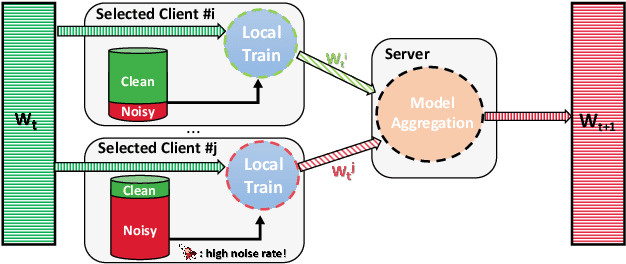
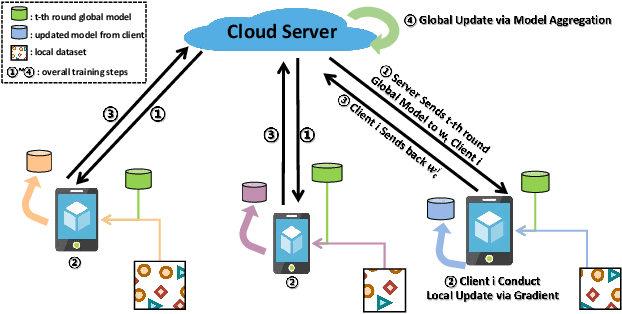

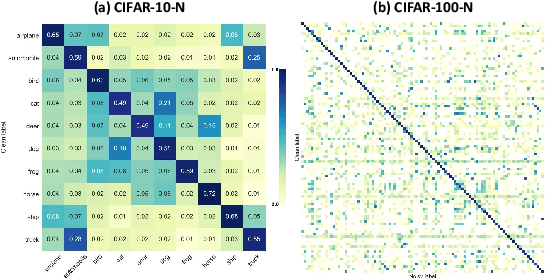
Abstract:Robustness to label noise within data is a significant challenge in federated learning (FL). From the data-centric perspective, the data quality of distributed datasets can not be guaranteed since annotations of different clients contain complicated label noise of varying degrees, which causes the performance degradation. There have been some early attempts to tackle noisy labels in FL. However, there exists a lack of benchmark studies on comprehensively evaluating their practical performance under unified settings. To this end, we propose the first benchmark study FNBench to provide an experimental investigation which considers three diverse label noise patterns covering synthetic label noise, imperfect human-annotation errors and systematic errors. Our evaluation incorporates eighteen state-of-the-art methods over five image recognition datasets and one text classification dataset. Meanwhile, we provide observations to understand why noisy labels impair FL, and additionally exploit a representation-aware regularization method to enhance the robustness of existing methods against noisy labels based on our observations. Finally, we discuss the limitations of this work and propose three-fold future directions. To facilitate related communities, our source code is open-sourced at https://github.com/Sprinter1999/FNBench.
Event-Based Eye Tracking. 2025 Event-based Vision Workshop
Apr 25, 2025Abstract:This survey serves as a review for the 2025 Event-Based Eye Tracking Challenge organized as part of the 2025 CVPR event-based vision workshop. This challenge focuses on the task of predicting the pupil center by processing event camera recorded eye movement. We review and summarize the innovative methods from teams rank the top in the challenge to advance future event-based eye tracking research. In each method, accuracy, model size, and number of operations are reported. In this survey, we also discuss event-based eye tracking from the perspective of hardware design.
 Add to Chrome
Add to Chrome Add to Firefox
Add to Firefox Add to Edge
Add to Edge